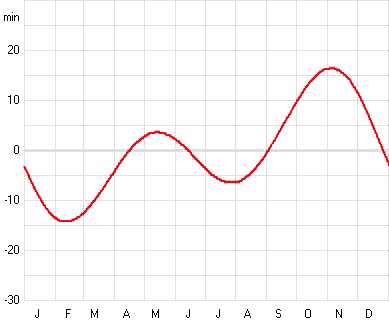Equation of Time
Apparent solar time and mean solar time
Equation of Time
Practical implications
Apparent solar time and mean solar time
According to apparent solar time one day is the time elapsed from the Sun reaching it's daily high in the south until it happens the next time (noon-to-noon time).
Problem is, that this time interval isn't exactly the same every day. This became clear as clocks and watches grew more precise.
To overcome this problem, mean solar time was defined: one day is defined as the mean length of a day over one year.
This raises a new problem: noon will not be at exactly 12 o'clock every day.
Read more about this on: Time and solar time (currently in Danish).
Equation of Time
The daily difference between apparent and mean solar time is called Equation of Time
.
Below the Equation of Time throughout a year is shown.
Only four times during a year the difference is zero. And the difference is between -14 to +17 minutes, which is pretty much.

Practical implications
When you're using mean solar time, time for noon will move, but along with this
all times of the day will move accordingly, and this influences the way
daylength is changing during the year.
From January until the start of February daylength will increase, but as noon time moves forward, the
increase mainly results from the sun setting later.
From mid February until start of May the daylength mainly increases in the morning.
From mid August until October the day shortens in the evening, rest of the year mainly in the morning.